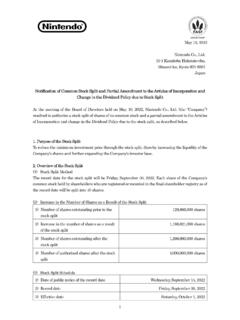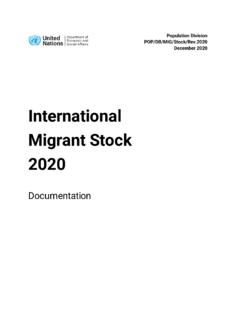Transcription of Testing for Weak Instruments in Linear IV Regression
1 Testing for Weak Instruments in Linear IV Regression August 2001 (This revision: February 2003) James H. Stock Department of Economics, Harvard University and the National Bureau of Economic Research and Motohiro Yogo* Department of Economics, Harvard University ABSTRACT Weak Instruments can produce biased IV estimators and hypothesis tests with large size distortions. But what, precisely, are weak Instruments , and how does one detect them in practice? This paper proposes quantitative definitions of weak Instruments based on the maximum IV estimator bias, or the maximum Wald test size distortion, when there are multiple endogenous regressors. We tabulate critical values that enable using the first-stage F-statistic (or, when there are multiple endogenous regressors, the Cragg-Donald (1993) statistic) to test whether given Instruments are weak. *Prepared for the Festschrift in honor of Thomas Rothenberg. We thank Alastair Hall, Jerry Hausman, Takesi Hayakawa, George Judge, Whitney Newey, and Jonathan Wright for helpful comments and/or suggestions.
2 This research was supported by NSF grants SBR-9730489 and SBR-0214131. 1 1. Introduction Standard treatments of instrumental variables (IV) Regression stress that for Instruments to be valid they must be exogenous. It is also important, however, that the second condition for a valid instrument, instrument relevance, holds, for if the Instruments are only marginally relevant, or weak, then first-order asymptotics can be a poor guide to the actual sampling distributions of conventional IV Regression statistics. At a formal level, the strength of the Instruments matters because the natural measure of this strength the so-called concentration parameter plays a role formally akin to the sample size in IV Regression statistics. Rothenberg (1984) makes this point in his survey of approximations to the distributions of estimators and test statistics. He considered the single equation IV Regression model, y = Y + u, ( ) where y and Y are T 1 vectors of observations on the dependent variable and endogenous regressor, respectively, and u is a T 1 vector of N(0, uu) errors.
3 The reduced form equation for Y is Y = Z + V, ( ) where Z is a T K2 matrix of fixed, exogenous instrumental variables, is a K2 1 coefficient vector, and V is a T 1 vector of N(0, VV) errors, where corr(ut,Vt) = . 2 The two stage least squares (TSLS) estimator of is TSLSb = (Y PZy)/ (Y PZY), where PZ = Z(Z Z)-1Z . Rothenberg (1984) expresses TSLSb as ( TSLSb ) = 1/ 22(/)1(2/ ) (/)uuuVuVVVVVSS szmszmm + ++ , ( ) where u = Z u/( uu Z Z )1/2, V = Z V/( VV Z Z )1/2, SVu = V PZu/( uu VV)1/2, SVV = V PZV/ VV, and is the square root of the concentration parameter, 2 = Z Z / VV. Under the assumptions of fixed Instruments and normal errors, u and V are standard normal variables with correlation , and SVu and SVV are elements of a matrix with a central Wishart distribution. Because the distributions of u, V, SVu, and SVV do not depend on the sample size, the sample size enters the distribution of the TSLS estimator only through the concentration parameter.
4 In fact, the form of ( ) makes it clear that 2 can be thought of as an effective sample size, in the sense that formally plays the role usually associated with T. Rothenberg (1984) proceeds to discuss expansions of the distribution of the TSLS estimator in orders of , and he emphasizes that the quality of these approximations can be poor when 2 is small. This has been underscored by the dramatic numerical results of Nelson and Startz (1990a, 1990b) and Bound, Jaeger and Baker (1995). If 2 is so small that inference based on some IV estimators and their conventional standard errors are potentially unreliable, then the Instruments are said to be 3 weak. But this raises two practical questions. First, precisely how small must 2 be for Instruments to be weak? Second, because , and thus 2, is unknown, how is an applied researcher to know whether 2 is in fact sufficiently small that his or her Instruments are weak? This paper provides answers to these two questions. First, we develop precise, quantitative definitions of weak Instruments for the general case of n endogenous regressors.
5 In our view, the matter of whether a group of instrumental variables is weak cannot be resolved in the abstract; rather, it depends on the inferential task to which the Instruments are applied and how that inference is conducted. We therefore offer two alternative definitions of weak Instruments . The first definition is that a group of Instruments is weak if the bias of the IV estimator, relative to the bias of ordinary least squares (OLS), could exceed a certain threshold b, for example 10%. The second is that the Instruments are weak if the conventional -level Wald test based on IV statistics has an actual size that could exceed a certain threshold r, for example r = 10% when = 5%. Each of these definitions yields a set of population parameters that defines weak Instruments , that is, a weak instrument set. Because different estimators ( , TSLS or LIML) have different properties when Instruments are weak, the resulting weak instrument set depends on the estimator being used.
6 For TSLS and other k-class estimators, we argue that these weak instrument sets can be characterized in terms of the minimum eigenvalue of the matrix version of 2/K2. Second, given this quantitative definition of weak instrument sets, we show how to test the null hypothesis that a given group of Instruments is weak against the alternative that it is strong. Our test is based on the Cragg-Donald (1993) statistic; when 4 there is a single endogenous regressor, this statistic is simply the first-stage F-statistic , the F-statistic for Testing the hypothesis that the Instruments do not enter the first stage Regression of TSLS. The critical values for the test statistic, however, are not Cragg and Donald s (1993): our null hypothesis is that the Instruments are weak, even though the parameters might be identified, whereas Cragg and Donald (1993) test the null hypothesis of underidentification. We therefore provide tables of critical values that depend on the estimator being used, whether the researcher is concerned about bias or size distortion, and the numbers of Instruments and endogenous regressors.
7 These critical values are obtained using weak instrument asymptotic distributions (Staiger and Stock (1997)), which are more accurate than Edgeworth approximations when the concentration parameter is This paper is part of a growing literature on detecting weak Instruments , surveyed in Stock, Wright, and Yogo (2002) and Hahn and Hausman (2003). Cragg and Donald (1993) proposed a test of underidentification, which (as discussed above) is different from a test for weak Instruments . Hall, Rudebusch, and Wilcox (1996), following the work by Bowden and Turkington (1984), suggested Testing for underidentification using the minimum canonical correlation between the endogenous regressors and the Instruments . Shea (1997) considered multiple included regressors and suggested looking at a partial R2. Neither Hall, Rudebusch, and Wilcox (1996) nor Shea (1997) provide a formal characterization of weak instrument sets or a formal test for weak Instruments , with controlled type I error, based on their respective statistics.
8 For the case of a single endogenous regressor, Staiger and Stock (1997) suggested declaring Instruments to be weak if the first-stage F-statistic is less than ten. Recently Hahn and Hausman (2002) 5 suggested comparing the forward and reverse TSLS estimators and concluding that Instruments are strong if the null hypothesis that these are the same cannot be rejected. Relative to this literature, the contribution of this paper is twofold. First, we provide a formal characterization of the weak instrument set for a general number of endogenous regressors. Second, we provide a test of whether given Instruments fall in this set, that is, whether they are weak, where the size of the test is controlled asymptotically under the null of weak Instruments . The rest of the paper is organized as follows. The IV Regression model and the proposed test statistic are presented in Section 2. The weak instrument sets are developed in Section 3. Section 4 presents the test for weak Instruments and provides critical values for tests based on TSLS bias and size, Fuller-k bias, and LIML size.
9 Section 5 examines the power of the test, and conclusions are presented in Section 6. 2. The IV Regression Model, the Proposed Test Statistic, and Weak Instrument Asymptotics The IV Regression Model We consider the Linear IV Regression model ( ) and ( ), generalized to have n included endogenous regressors Y and K1 included exogenous regressors X: y = Y + X + u, ( ) Y = Z + X + V, ( ) 6 where Y is now a T n matrix of included endogenous variables, X is a T K1 matrix of included exogenous variables (one column of which is 1 s if ( ) includes an intercept), Z is a T K2 matrix of excluded exogenous variables to be used as Instruments , and the error matrix V is T n. It is assumed throughout that K2 n. Let Y = [y Y] and Z = [X Z] respectively denote the matrices of all the endogenous and exogenous variables. The conformable vectors and and the matrices and are unknown parameters. Throughout this paper we exclusively consider inference about . Let Xt = ()11tKtXX" , Zt = ()21tKtZZ" , Vt = ()1tntVV" , and Zt = (Xt Zt ) denote the vectors of the tth observations on these variables.
10 Also let and Q denote the population second moment matrices, ()t'tuuuttuuEus == VVVVVVSSSS and E(Zt Zt ) = ZX = XXXZZZQQQQQ. ( ) k-Class Estimators and Wald Statistics Let the superscript denote the residuals from the projection on X, so for example Y = MXY, where MX = I X(X X)-1X . In this notation, the OLS estimator of is b = (Y Y )-1(Y y). The k-class estimator of is ()kb = [Y (I - k^ZM)Y ]-1[Y (I - k^ZM)y ]. ( ) 7 The Wald statistic, based on the k-class estimator, Testing the null hypothesis that = 0, is W(k) = 00 [()]'[ '() ][ ()] ()uukIk knks^^^ ZYMY bbbb , ( ) where ()uuk = ()k u ()k u/(T K1 n), where ()k u= y Y ()kb. This paper considers four specific k-class estimators: TSLS, the limited information maximum likelihood estimator (LIML), the family of modified LIML estimators proposed by Fuller (1977) ( Fuller-k estimators ), and bias-adjusted TSLS (BTSLS; Nagar (1959), Rothenberg (1984)).
















